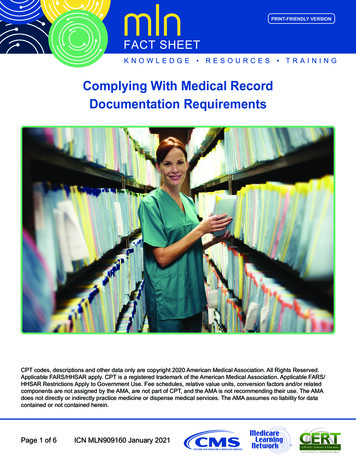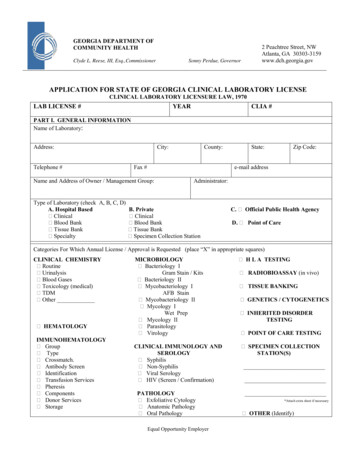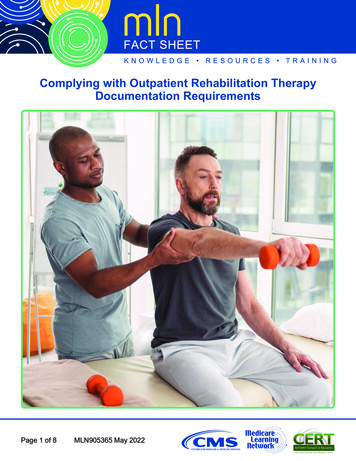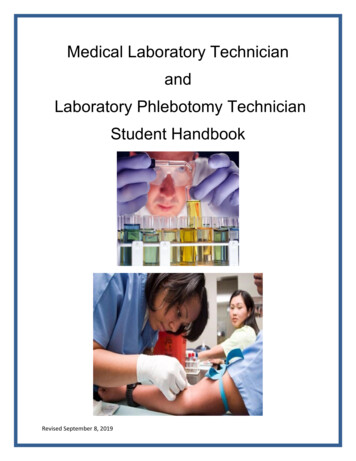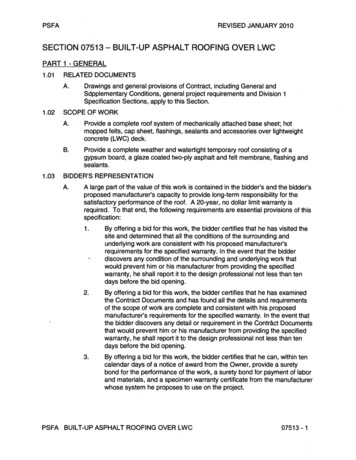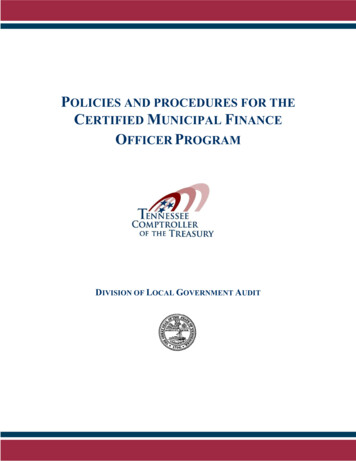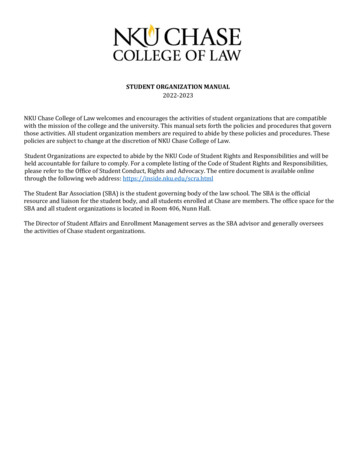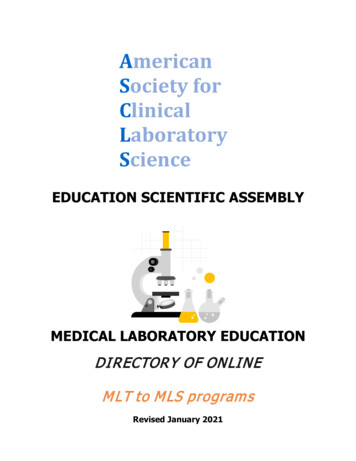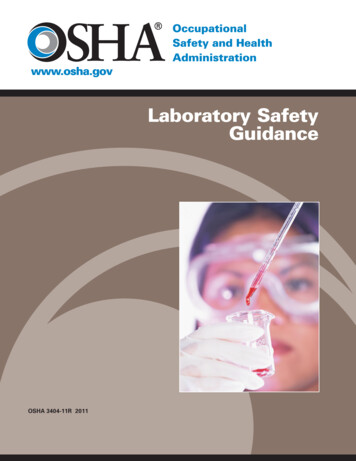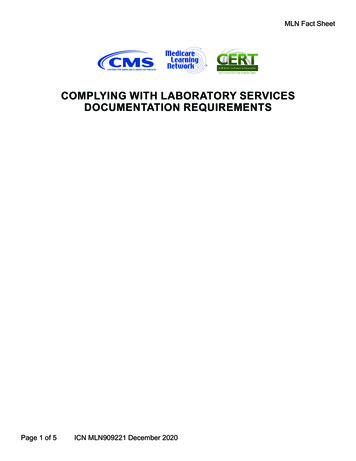
Transcription
MLN Fact SheetCOMPLYING WITH LABORATORY SERVICESDOCUMENTATION REQUIREMENTSPage 1 of 5ICN MLN909221 December 2020
Complying with Laboratory ServicesDocumentation RequirementsMLN Fact SheetUpdatesNote: We revised this product with the following content updates: Clarified documentation requirements to add language acceptable to Medical ReviewContractors auditing records for regulatory guidance compliance Added clarification to the term “standing orders”Page 2 of 5ICN MLN909221 December 2020
Complying with Laboratory ServicesDocumentation RequirementsMLN Fact SheetIntroductionThe majority of improper laboratory services payments identified by the Comprehensive Error RateTesting (CERT) Program are due to insufficient documentation. Insufficient documentation meanssomething is missing from the medical records. Examples include: Documentation to support intent to order, such as a signed progress note, signed office visit note, orsigned physician order Documentation to support the medical necessity of ordered servicesRemember the following tips to help you avoid errors.Documentation Requirements The physician who treats a patient must order all diagnostic x-rays, diagnostic laboratory tests, andother diagnostic tests for a specific medical problem. The physician uses test results to managethe patient’s specific medical problem and may provide a consultation. Tests not ordered by thephysician aren’t considered reasonable and necessary. The physician should clearly indicate all tests to be performed (for example, “run labs” or “checkblood” by itself doesn’t support intent to order) when completing progress notes. Medical reviewcontractors will consider diagnostic test order requirements met if there’s: A signed order or requisition listing the specific test An unsigned order or requisition listing the specific test(s) and an authenticated medical recordsupporting the physician’s intent to order the tests (for example, “order labs”, “check blood”,“repeat urine”) An authenticated medical record supporting the physician intent to order specific tests Documentation in the patient’s medical record must support the medical necessity for orderingthe service(s) per Medicare regulations and applicable Local Coverage Determinations (LCDs).Submit these medical records if they’re requested. These records need to be available to submit upon request: Progress notes or office notes Physician order or intent to order Laboratory results Attestation or signature log for illegible signaturesFor more information about signature requirements and attestation statements, refer to theMedicare Simplifying Documentation Requirements webpage or the Complying with MedicareSignature Requirements fact sheet.Page 3 of 5ICN MLN909221 December 2020
Complying with Laboratory ServicesDocumentation RequirementsMLN Fact SheetMedicare Signature Requirements Unsigned physician orders or unsigned requisitions alone don’t support physician intent to order. Physicians should sign all orders for diagnostic services to avoid potential denials. If the signature is missing on a progress note, which supports intent, the ordering physician mustcomplete an attestation statement and submit it with the response. For an example of a signatureattestation statement, visit the CERT Provider website. If the signature is illegible, an attestationstatement or signature log is acceptable. Attestation statements are unacceptable for unsigned physician orders or requisitions.Ordering or Referring ServicesIf you bill laboratory services to Medicare, you must get the treating physician’s signed order (orprogress note to support intent to order) and documentation to support medical necessity for orderedservices. These records may be housed at another location (for example, a nursing facility, hospital,or referring physician’s office).While a signature isn’t required on the physician order, the physician must clearly document in themedical record their intent to perform the test.Providers should be aware of the various meanings of the term “standing orders.” Some understandthis to mean recurring orders specific to the care of an individual patient. Others interpret this as routineorders for services delivered to a population of patients. Only medically necessary services orderedand rendered, including those based on treatment protocols, are considered for reimbursement whendocumentation supports the orders and/or protocols are individualized to each patient.If you order diagnostic services for Medicare patients, you must also maintain documentation ofthe order (including standing orders and protocols) or intent to order and medical necessity of theservices in the patient’s medical record. Keep this information available and submit it, along with thetest results, upon request for a Medicare claim review. For information on “access to documentation,”refer to 42 CFR Section 424.516(f).Cooperation between ordering and referring providers and facilities that perform diagnostic tests is crucialto reducing errors and avoiding claim denials.The Medicare Learning Network (MLN) along with the CERT Part A and Part B (A/B) MACOutreach & Education Task Forces, developed this fact sheet to offer nationally consistent educationon topics of interest to health care professionals. Visit the CMS CERT webpage to learn about theCERT Program and review CERT Improper Payments Reports. CMS started the CERT Programto measure improper payments in the Medicare Fee-for-Service (FFS) Program. Under the CERTProgram, a random sample of all Medicare FFS claims are reviewed to determine if they were paidproperly under Medicare coverage, coding, and billing rules. Two contractors manage the CERTProgram: the CERT Statistical Contractor (CERT SC) and the CERT Review Contractor (CERT RC).The CERT SC determines Medicare claims sampling and calculates the improper payment.Page 4 of 5ICN MLN909221 December 2020
Complying with Laboratory ServicesDocumentation RequirementsMLN Fact SheetKey Takeaways A signed order, a signed requisition, or a signed medical record supporting the physician’sintent to order tests (for example, “order labs”, “check blood”, “repeat urine”) satisfies the orderrequirement for laboratory tests. Ensure all diagnostic laboratory services documentation includes the order (including standingorders) or intent to order and medical necessity of the services. An unsigned order or requisition listing of specific tests is only acceptable if it’s accompanied byan authenticated medical record supporting the physician’s intent to order the tests.Resources 42 CFR Section 410.32 Diagnostic X-Ray Tests, Diagnostic Laboratory Tests, and OtherDiagnostic Tests: Conditions Medicare Benefit Policy Manual, Chapter 15, Section 80.6 Medicare Claims Processing Manual, Chapter 16 Medicare National Coverage Determinations Manual, Chapter 1, Part 3, Section 190 Medicare Program Integrity Manual, Chapter 3, Sections, 3.2.3.3 and 3.2.3.7 Provider Compliance WebpageThe Comprehensive Error Rate Testing (CERT) Part A and Part B (A/B) Medicare Administrative Contractor (MAC)Outreach & Education Task Force is independent from the Centers for Medicare & Medicaid Services (CMS) CERT teamand CERT contractors, which are responsible for calculation of the Medicare Fee-for-Service improper payment rate.Medicare Learning Network Content Disclaimer, Product Disclaimer, and Department of Health & Human Services DisclosureThe Medicare Learning Network , MLN Connects , and MLN Matters are registered trademarks of the U.S. Departmentof Health & Human Services (HHS).Page 5 of 5ICN MLN909221 December 2020
§410.32 Diagnostic x-ray tests, diagnostic laboratory tests, and other diagnostic tests: Conditions. §410.32 Diagnostic x-ray tests, diagnostic laboratory tests, and other diagnostic tests: Conditions. Medicare Benefit Policy Manual, Chapter 15, Section 80.6. Medicare Claims Processing Manual, Chapter 16
